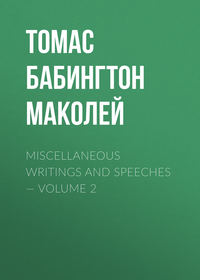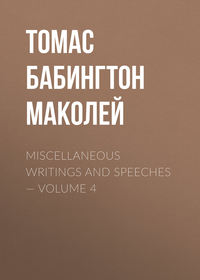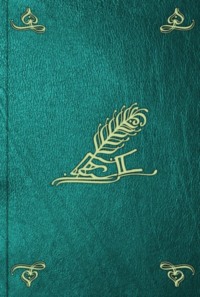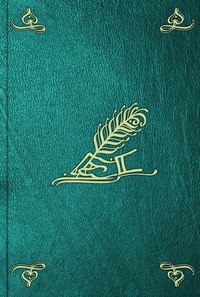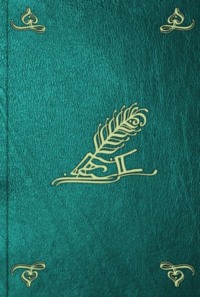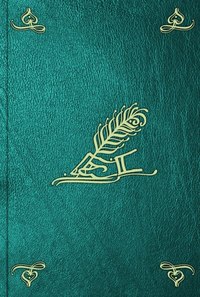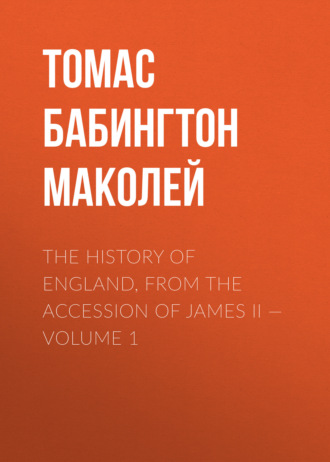 полная версия
полная версияThe History of England, from the Accession of James II — Volume 1
65 (return)
Evelyn's Diary, June 2, 1675.
66 (return)
See White's Selborne; Bell's History of British Quadrupeds, Gentleman's Recreation, 1686; Aubrey's Natural History of Wiltshire, 1685; Morton's History of Northamptonshire, 1712; Willoughby's Ornithology, by Ray, 1678; Latham's General Synopsis of Birds; and Sir Thomas Browne's Account of Birds found in Norfolk.
67 (return)
King's Natural and Political Conclusions. Davenant on the Balance of Trade.
68 (return)
See the Almanacks of 1684 and 1685.
69 (return)
See Mr. M'Culloch's Statistical Account of the British Empire, Part III. chap. i. sec. 6.
70 (return)
King and Davenant as before The Duke of Newcastle on Horsemanship; Gentleman's Recreation, 1686. The "dappled Flanders mares" were marks of greatness in the time of Pope, and even later. The vulgar proverb, that the grey mare is the better horse, originated, I suspect, in the preference generally given to the grey mares of Flanders over the finest coach horses of England.
71 (return)
See a curious note by Tonkin, in Lord De Dunstanville's edition of Carew's Survey of Cornwall.
72 (return)
Borlase's Natural History of Cornwall, 1758. The quantity of copper now produced, I have taken from parliamentary returns. Davenant, in 1700, estimated the annual produce of all the mines of England at between seven and eight hundred thousand pounds
73 (return)
Philosophical Transactions, No. 53. Nov. 1669, No. 66. Dec. 1670, No. 103. May 1674, No 156. Feb. 1683-4
74 (return)
Yarranton, England's Improvement by Sea and Land, 1677; Porter's Progress of the Nation. See also a remarkably perspicnous history, in small compass of the English iron works, in Mr. M'Culloch's Statistical Account of the British Empire.
75 (return)
See Chamberlayne's State of England, 1684, 1687, Angliae, Metropolis, 1691; M'Culloch's Statistical Account of the British Empire Part III. chap. ii. (edition of 1847). In 1845 the quantity of coal brought into London appeared, by the Parliamentary returns, to be 3,460,000 tons. (1848.) In 1854 the quantity of coal brought into London amounted to 4,378,000 tons. (1857.)
76 (return)
My notion of the country gentleman of the seventeenth century has been derived from sources too numerous to be recapitulated. I must leave my description to the judgment of those who have studied the history and the lighter literature of that age.
77 (return)
In the eighteenth century the great increase in the value of benefices produced a change. The younger sons of the nobility were allured back to the clerical profession. Warburton in a letter to Hurd, dated the 6th of July, 1762, mentions this change, which was then recent. "Our grandees have at last found their way back into the Church. I only wonder they have been so long about it. But be assured that nothing but a new religious revolution, to sweep away the fragments that Henry the Eighth left after banqueting his courtiers, will drive them out again."
78 (return)
See Heylin's Cyprianus Anglicus.
79 (return)
Eachard, Causes of the Contempt of the Clergy; Oldham, Satire addressed to a Friend about to leave the University; Tatler, 255, 258. That the English clergy were a lowborn class, is remarked in the Travels of the Grand Duke Cosmo, Appendix A.
80 (return)
"A causidico, medicastro, ipsaque artificum farragine, ecclesiae rector aut vicarius contemnitur et fit ludibrio. Gentis et familiae nitor sacris ordinibus pollutus censetur: foeminisque natalitio insignibus unicum inculcatur saepius praeceptum, ne modestiae naufragium faciant, aut, (quod idem auribus tam delicatulis sonat,) ne clerico se nuptas dari patiantur."—Angliae Notitia, by T. Wood, of New College Oxford 1686.
81 (return)
Clarendon's Life, ii. 21.
82 (return)
See the injunctions of 1559, In Bishop Sparrow's Collection. Jeremy Collier, in his Essay on Pride, speaks of this injunction with a bitterness which proves that his own pride had not been effectually tamed.
83 (return)
Roger and Abigail in Fletcher's Scornful Lady, Bull and the Nurse in Vanbrugh's Relapse, Smirk and Susan in Shadwell's Lancashire Witches, are instances.
84 (return)
Swift's Directions to Servants. In Swift's Remarks on the Clerical Residence Bill, he describes the family of an English vicar thus: "His wife is little better than a Goody, in her birth, education, or dress..... His daughters shall go to service, or be sent apprentice to the sempstress of the next town."
85 (return)
Even in Tom Jones, published two generations later. Mrs. Seagrim, the wife of a gamekeeper, and Mrs. Honour, a waitingwoman, boast of their descent from clergymen, "It is to be hoped," says Fielding, "such instances will in future ages, when some provision is made for the families of the inferior clergy, appear stranger than they can be thought at present."
86 (return)
This distinction between country clergy and town clergy is strongly marked by Eachard, and cannot but be observed by every person who has studied the ecclesiastical history of that age.
87 (return)
Nelson's Life of Bull. As to the extreme difficulty which the country clergy found in procuring books, see the Life of Thomas Bray, the founder of the Society for the Propagation of the Gospel.
88 (return)
"I have frequently heard him (Dryden) own with pleasure, that if he had any talent for English prose it was owing to his having often read the writings of the great Archbishop Tillotson."—Congreve's Dedication of Dryden's Plays.
89 (return)
I have taken Davenant's estimate, which is a little lower than King's.
90 (return)
Evelvn's Diary, June 27. 1654; Pepys's Diary, June 13. 1668; Roger North's Lives of Lord Keeper Guildford, and of Sir Dudley North; Petty's Political Arithmetic. I have taken Petty's facts, but, in drawing inferences from them, I have been guided by King and Davenant, who, though not abler men than he, had the advantage of coming after him. As to the kidnapping for which Bristol was infamous, see North's Life of Guildford, 121, 216, and the harangue of Jeffreys on the subject, in the Impartial History of his Life and Death, printed with the Bloody Assizes. His style was, as usual, coarse, but I cannot reckon the reprimand which he gave to the magistrates of Bristol among his crimes.
91 (return)
Fuller's Worthies; Evelyn's Diary, Oct. 17,1671; Journal of T. Browne, son of Sir Thomas Browne, Jan. 1663-4; Blomefield's History of Norfolk; History of the City and County of Norwich, 2 vols. 1768.
92 (return)
The population of York appears, from the return of baptisms and burials in Drake's History, to have been about 13,000 in 1730. Exeter had only 17,000 inhabitants in 1801. The population of Worcester was numbered just before the siege in 1646. See Nash's History of Worcestershire. I have made allowance for the increase which must be supposed to have taken place in forty years. In 1740, the population of Nottingham was found, by enumeration, to be just 10,000. See Dering's History. The population of Gloucester may readily be inferred from the number of houses which King found in the returns of hearth money, and from the number of births and burials which is given in Atkyns's History. The population of Derby was 4,000 in 1712. See Wolley's MS. History, quoted in Lyson's Magna Britannia. The population of Shrewsbury was ascertained, in 1695, by actual enumeration. As to the gaieties of Shrewsbury, see Farquhar's Recruiting Officer. Farquhar's description is borne out by a ballad in the Pepysian Library, of which the burden is "Shrewsbury for me."
93 (return)
Blome's Britannia, 1673; Aikin's Country round Manchester; Manchester Directory, 1845: Baines, History of the Cotton Manufacture. The best information which I have been able to find, touching the population of Manchester in the seventeenth century is contained in a paper drawn up by the Reverend R. Parkinson, and published in the Journal of the Statistical Society for October 1842.
94 (return)
Thoresby's Ducatus Leodensis; Whitaker's Loidis and Elmete; Wardell's Municipal History of the Borough of Leeds. (1848.) In 1851 Leeds had 172,000 Inhabitants. (1857.)
95 (return)
Hunter's History of Hallamshire. (1848.) In 1851 the population of Sheffield had increased to 135,000. (1857.)
96 (return)
Blome's Britannia, 1673; Dugdale's Warwickshire, North's Examen, 321; Preface to Absalom and Achitophel; Hutton's History of Birmingham; Boswell's Life of Johnson. In 1690 the burials at Birmingham were 150, the baptisms 125. I think it probable that the annual mortality was little less than one in twenty-five. In London it was considerably greater. A historian of Nottingham, half a century later, boasted of the extraordinary salubrity of his town, where the annual mortality was one in thirty. See Doring's History of Nottingham. (1848.) In 1851 the population of Birmingham had increased to 222,000. (1857.)
97 (return)
Blome's Britannia; Gregson's Antiquities of the County Palatine and Duchy of Lancaster, Part II.; Petition from Liverpool in the Privy Council Book, May 10, 1686. In 1690 the burials at Liverpool were 151, the baptisms 120. In 1844 the net receipt of the customs at Liverpool was 4,366,526£. 1s. 8d. (1848.) In 1851 Liverpool contained 375,000 inhabitants, (1857.)
98 (return)
Atkyne's Gloucestershire.
99 (return)
Magna Britannia; Grose's Antiquities; New Brighthelmstone Directory.
100 (return)
Tour in Derbyshire, by Thomas Browne, son of Sir Thomas.
101 (return)
Memoires de Grammont; Hasted's History of Kent; Tunbridge Wells, a Comedy, 1678; Causton's Tunbridgialia, 1688; Metellus, a poem on Tunbridge Wells, 1693.
102 (return)
See Wood's History of Bath, 1719; Evelyn's Diary, June 27,1654; Pepys's Diary, June 12, 1668; Stukeley's Itinerarium Curiosum; Collinson's Somersetshire; Dr. Peirce's History and Memoirs of the Bath, 1713, Book I. chap. viii. obs. 2, 1684. I have consulted several old maps and pictures of Bath, particularly one curious map which is surrounded by views of the principal buildings. It Dears the date of 1717.
103 (return)
According to King 530,000. (1848.) In 1851 the population of London exceeded, 2,300,000. (1857.)
104 (return)
Macpherson's History of Commerce; Chalmers's Estimate; Chamberlayne's State of England, 1684. The tonnage of the steamers belonging to the port of London was, at the end of 1847, about 60,000 tons. The customs of the port, from 1842 to 1845, very nearly averaged 11,000,000£. (1848.) In 1854 the tonnage of the steamers of the port of London amounted to 138,000 tons, without reckoning vessels of less than fifty tons. (1857.)
105 (return)
Lyson's Environs of London. The baptisms at Chelsea, between 1680 and 1690, were only 42 a year.
106 (return)
Cowley, Discourse of Solitude.
107 (return)
The fullest and most trustworthy information about the state of the buildings of London at this time is to be derived from the maps and drawings in the British Museum and in the Pepysian Library. The badness of the bricks in the old buildings of London is particularly mentioned in the Travels of the Grand Duke Cosmo. There is an account of the works at Saint Paul's in Ward's London Spy. I am almost ashamed to quote such nauseous balderdash; but I have been forced to descend even lower, if possible, in search of materials.
108 (return)
Evelyn's Diary, Sept. 20. 1672.
109 (return)
Roger North's Life of Sir Dudley North.
110 (return)
North's Examen. This amusing writer has preserved a specimen of the sublime raptures in which the Pindar of the City indulged:—
"The worshipful sir John Moor! After age that name adore!"111 (return)
Chamberlayne's State of England, 1684; Anglie Metropolis, 1690; Seymour's London, 1734.
112 (return)
North's Examen, 116; Wood, Ath. Ox. Shaftesbury; The Duke of B.'s Litany.
113 (return)
Travels of the Grand Duke Cosmo.
114 (return)
Chamberlayne's State of England, 1684; Pennant's London; Smith's Life of Nollekens.
115 (return)
Evelyn's Diary, Oct. 10, 1683, Jan. 19, 1685-6.
116 (return)
Stat. 1 Jac. II. c. 22; Evelyn's Diary, Dec, 7, 1684.
117 (return)
Old General Oglethorpe, who died in 1785, used to boast that he had shot birds here in Anne's reign. See Pennant's London, and the Gentleman's Magazine for July, 1785.
118 (return)
The pest field will be seen in maps of London as late as the end of George the First's reign.
119 (return)
See a very curious plan of Covent Garden made about 1690, and engraved for Smith's History of Westminster. See also Hogarth's Morning, painted while some of the houses in the Piazza were still occupied by people of fashion.
120 (return)
London Spy, Tom Brown's comical View of London and Westminster; Turner's Propositions for the employing of the Poor, 1678; Daily Courant and Daily Journal of June 7, 1733; Case of Michael v. Allestree, in 1676, 2 Levinz, p. 172. Michael had been run over by two horses which Allestree was breaking in Lincoln's Inn Fields. The declaration set forth that the defendant "porta deux chivals ungovernable en un coach, et improvide, incante, et absque debita consideratione ineptitudinis loci la eux drive pur eux faire tractable et apt pur an coach, quels chivals, pur ceo que, per leur ferocite, ne poientestre rule, curre sur le plaintiff et le noie."
121 (return)
Stat. 12 Geo. I. c. 25; Commons' Journals, Feb. 25, March 2, 1725-6; London Gardener, 1712; Evening Post, March, 23, 1731. I have not been able to find this number of the Evening Post; I therefore quote it on the faith of Mr. Malcolm, who mentions it in his History of London.
122 (return)
Lettres sur les Anglois, written early in the reign of William the Third; Swift's City Shower; Gay's Trivia. Johnson used to relate a curious conversation which he had with his mother about giving and taking the wall.
123 (return)
Oldham's Imitation of the 3d Satire of Juvenal, 1682; Shadwell's Scourers, 1690. Many other authorities will readily occur to all who are acquainted with the popular literature of that and the succeeding generation. It may be suspected that some of the Tityre Tus, like good Cavaliers, broke Milton's windows shortly after the Restoration. I am confident that he was thinking of those pests of London when he dictated the noble lines:
"And in luxurious cities, when the noise Of riot ascends above their loftiest towers, And injury and outrage, and when night Darkens the streets, then wander forth the sons Of Belial, flown With innocence and wine."124 (return)
Seymour's London.
125 (return)
Angliae Metropolis, 1690, Sect. 17, entitled, "Of the new lights"; Seymour's London.
126 (return)
Stowe's Survey of London; Shadwell's Squire of Alsatia; Ward's London Spy; Stat. 8 & 9 Gul. III. cap. 27.
127 (return)
See Sir Roger North's account of the way in which Wright was made a judge, and Clarendon's account of the way in which Sir George Savile was made a peer.
128 (return)
The sources from which I have drawn my information about the state of the Court are too numerous to recapitulate. Among them are the Despatches of Barillon, Van Citters, Ronquillo, and Adda, the Travels of the Grand Duke Cosmo, the works of Roger North, the Diares of Pepys, Evelyn, and Teonge, and the Memoirs of Grammont and Reresby.
129 (return)
The chief peculiarity of this dialect was that, in a large class of words, the O was pronounced like A. Thus Lord was pronounced Lard. See Vanbrugh's Relapse. Lord Sunderland was a great master of this court tune, as Roger North calls it; and Titus Oates affected it in the hope of passing for a fine gentleman. Examen, 77, 254.
130 (return)
Lettres sur les Anglois; Tom Brown's Tour; Ward's London Spy; The Character of a Coffee House, 1673; Rules and Orders of the Coffee House, 1674; Coffee Houses vindicated, 1675; A Satyr against Coffee; North's Examen, 138; Life of Guildford, 152; Life of Sir Dudley North, 149; Life of Dr. Radcliffe, published by Curll in 1715. The liveliest description of Will's is in the City and Country Mouse. There is a remarkable passage about the influence of the coffee house orators in Halstead's Succinct Genealogies, printed in 1685.
131 (return)
Century of inventions, 1663, No. 68.
132 (return)
North's Life of Guildford, 136.
133 (return)
Thoresby's Diary Oct. 21,1680, Aug. 3, 1712.
134 (return)
Pepys's Diary, June 12 and 16,1668.
135 (return)
Ibid. Feb. 28, 1660.
136 (return)
Thoresby's Diary, May 17,1695.
137 (return)
Ibid. Dec. 27,1708.
138 (return)
Tour in Derbyshire, by J. Browne, son of Sir Thomas Browne, 1662; Cotton's Angler, 1676.
139 (return)
Correspondence of Henry Earl of Clarendon, Dec. 30, 1685, Jan. 1, 1686.
140 (return)
Postlethwaite's Dictionary, Roads; History of Hawkhurst, in the Bibliotheca Topographica Britannica.
141 (return)
Annals of Queen Anne, 1703, Appendix, No. 3.
142 (return)
15 Car. II. c. 1.
143 (return)
The evils of the old system are strikingly set forth in many petitions which appear in the Commons' Journal of 172 5/6. How fierce an opposition was offered to the new system may be learned from the Gentleman's Magazine of 1749.
144 (return)
Postlethwaite's Dict., Roads.
145 (return)
Loidis and Elmete; Marshall's Rural Economy of England, In 1739 Roderic Random came from Scotland to Newcastle on a packhorse.
146 (return)
Cotton's Epistle to J. Bradshaw.
147 (return)
Anthony a Wood's Life of himself.
148 (return)
Chamberlayne's State of England, 1684. See also the list of stage coaches and waggons at the end of the book, entitled Angliae Metropolis, 1690.
149 (return)
John Cresset's Reasons for suppressing Stage Coaches, 1672. These reason were afterwards inserted in a tract, entitled "The Grand Concern of England explained, 1673." Cresset's attack on stage coaches called forth some answers which I have consulted.
150 (return)
Chamberlayne's State of England, 1684; North's Examen, 105; Evelyn's Diary, Oct. 9,10, 1671.
151 (return)
See the London Gazette, May 14, 1677, August 4, 1687, Dec. 5, 1687. The last confession of Augustin King, who was the son of an eminent divine, and had been educated at Cambridge but was hanged at Colchester in March, 1688, is highly curious.
152 (return)
Aimwell. Pray sir, han't I seen your face at Will's coffeehouse? Gibbet. Yes sir, and at White's too.—Beaux' Stratagem.
153 (return)
Gent's History of York. Another marauder of the same description, named Biss, was hanged at Salisbury in 1695. In a ballad which is in the Pepysian Library, he is represented as defending himself thus before the Judge:
"What say you now, my honoured Lord What harm was there in this? Rich, wealthy misers were abhorred By brave, freehearted Biss."154 (return)
Pope's Memoirs of Duval, published immediately after the execution. Oates's Eikwg basilikh, Part I.
155 (return)
See the prologue to the Canterbury Tales, Harrison's Historical Description of the Island of Great Britain, and Pepys's account of his tour in the summer of 1668. The excellence of the English inns is noticed in the Travels of the Grand Duke Cosmo.
156 (return)
Stat. 12 Car. II. c. 36; Chamberlayne's State of England, 1684; Angliae Metropolis, 1690; London Gazette, June 22, 1685, August 15, 1687.
157 (return)
Lond. Gaz., Sept. 14, 1685.
158 (return)
Smith's Current intelligence, March 30, and April 3, 1680.
159 (return)
Anglias Metropolis, 1690.
160 (return)
Commons' Journals, Sept. 4, 1660, March 1, 1688-9; Chamberlayne, 1684; Davenant on the Public Revenue, Discourse IV.
161 (return)
I have left the text as it stood in 1848. In the year 1856 the gross receipt of the Post Office was more than 2,800,000£.; and the net receipt was about 1,200,000£. The number of letters conveyed by post was 478,000,000. (1857).
162 (return)
London Gazette, May 5, and 17, 1680.
163 (return)
There is a very curious, and, I should think, unique collection of these papers in the British Museum.
164 (return)
For example, there is not a word in the Gazette about the important parliamentary proceedings of November, 1685, or about the trial and acquittal of the Seven Bishops.
165 (return)
Roger North's Life of Dr. John North. On the subject of newsletters, see the Examen, 133.
166 (return)
I take this opportunity of expressing my warm gratitude to the family of my dear and honoured friend sir James Mackintosh for confiding to me the materials collected by him at a time when he meditated a work similar to that which I have undertaken. I have never seen, and I do not believe that there anywhere exists, within the same compass, so noble a collection of extracts from public and private archives The judgment with which sir James in great masses of the rudest ore of history, selected what was valuable, and rejected what was worthless, can be fully appreciated only by one who has toiled after him in the same mine.
167 (return)
Life of Thomas Gent. A complete list of all printing houses in 1724 will be found in Nichols's Literary Anecdotae of the eighteenth century. There had then been a great increase within a few years in the number of presses, and yet there were thirty-four counties in which there was no printer, one of those counties being Lancashire.


